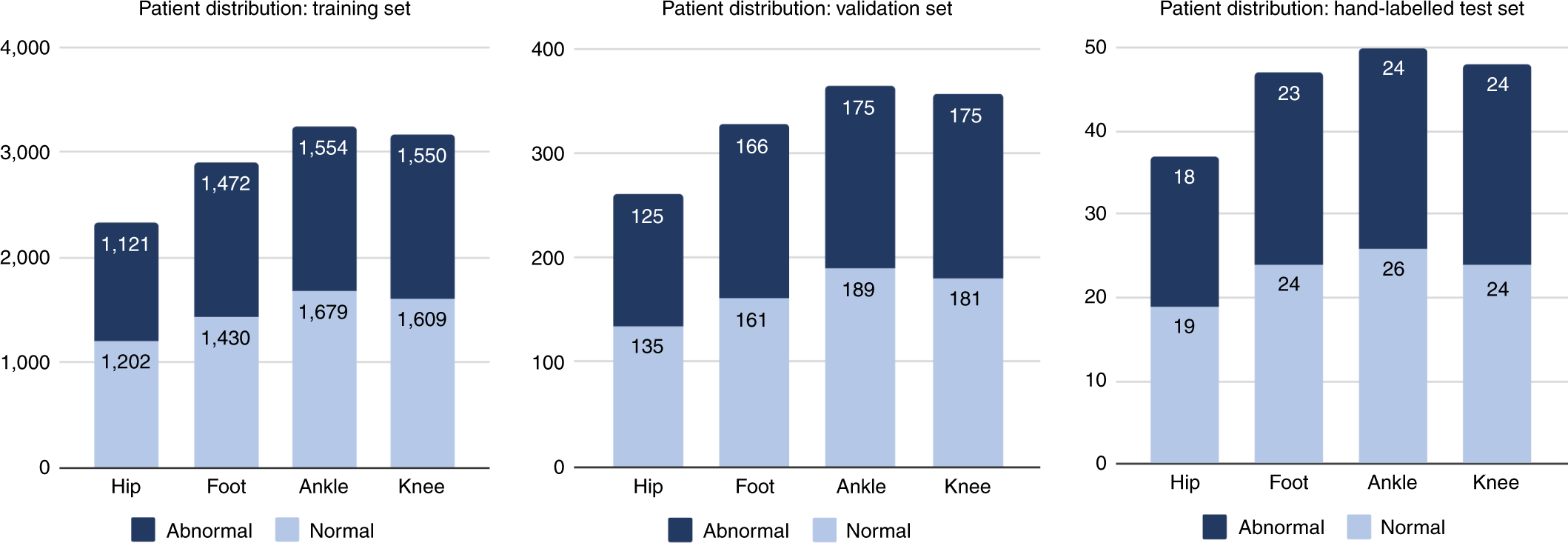Yelin, E., Weinstein, S. & King, T. The burden of musculoskeletal diseases in the United States. Semin. Arthritis Rheum. 46, 259–60. (2016).
Amin, S., Achenbach, S. J., Atkinson, E. J., Khosla, S. & Melton, L. J. III Trends in fracture incidence: a population-based study over 20 years. J. Bone Miner. Res. 29, 581–589 (2014).
Gyftopoulos, S. et al. Changing musculoskeletal extremity imaging utilization from 1994 through 2013: a Medicare beneficiary perspective. Am. J. Roentgenol. 209, 1103–1109 (2017).
Lee, C. S., Nagy, P. G., Weaver, S. J. & Newman-Toker, D. E. Cognitive and system factors contributing to diagnostic errors in radiology. Am. J. Roentgenol. 201, 611–617 (2013).
Bhargavan, M., Kaye, A. H., Forman, H. P. & Sunshine, J. H. Workload of radiologists in United States in 2006–2007 and trends since 1991–1992. Radiology 252, 458–467 (2009).
Rajpurkar, P. et al. MURA: large dataset for abnormality detection in musculoskeletal radiographs. Preprint at https://arxiv.org/abs/1712.06957 (2017).
Rajpurkar, P. et al. Deep learning for chest radiograph diagnosis: a retrospective comparison of the CheXNeXt algorithm to practicing radiologists. PLoS Med. 15, e1002686 (2018).
Thian, Y. L. et al. Convolutional neural networks for automated fracture detection and localization on wrist radiographs. Radiology: Artificial Intelligence 1, e180001 (2019).
Huh, M., Agrawal, P. & Efros, A. A. What makes ImageNet good for transfer learning? Preprint at https://arxiv.org/abs/1608.08614 (2016).
Rajpurkar, P. et al. CheXNet: radiologist-level pneumonia detection on chest X-rays with deep learning. Preprint at https://arxiv.org/abs/1711.05225 (2017).
Larson, D. B. et al. Performance of a deep-learning neural network model in assessing skeletal maturity on pediatric hand radiographs. Radiology. 287, 313–22. (2018).
Antony, J., McGuinness, K., O’Connor, N. E. & Moran K. Quantifying radiographic knee osteoarthritis severity using deep convolutional neural networks. In Proceedings of the International Conference on Pattern Recognition 1195–1200 (2017).
Bi, L., Kim, J., Kumar, A. & Feng, D. Automatic liver lesion detection using cascaded deep residual networks. Preprint at https://arxiv.org/abs/1704.02703 (2017).
Zhang, R. et al. Automatic detection and classification of colorectal polyps by transferring low-level CNN features from nonmedical domain. IEEE J. Biomed. Health Inform. 21, 41–47 (2017).
Gulshan, V. et al. Development and validation of a deep learning algorithm for detection of diabetic retinopathy in retinal fundus photographs. JAMA 316, 2402–2410 (2016).
Greenspan, H. et al. Guest editorial deep learning in medical imaging: overview and future promise of an exciting new technique. IEEE Trans. Med. Imaging 35, 1153–1159 (2016).
Kermany, D. S. et al. Identifying medical diagnoses and treatable diseases by image-based deep learning. Cell 172, 1122–1131 (2018).
Yan, C. et al. Weakly supervised deep learning for thoracic disease classification and localization on chest X-rays. Preprint at https://arxiv.org/abs/1807.06067 (2018).
Bar, Y. et al. Chest pathology detection using deep learning with non-medical training. In Proceedings of the International Symposium on Biomedical Imaging 294–297 (2015).
Olczak, J. et al. Artificial intelligence for analyzing orthopedic trauma radiographs: deep learning algorithms—are they on par with humans for diagnosing fractures? Acta Orthop. 88, 581–586 (2017).
Lindsey, R. et al. Deep neural network improves fracture detection by clinicians. Proc. Natl Acad. Sci. USA 115, 11591–11596 (2018).
Zhou, B., Khosla, A., Lapedriza, A., Oliva, A. & Torralba, A. Learning deep features for discriminative localization. In Proceedings of the IEEE Computer Society Conference on Computer Vision and Pattern Recognition 2921–2929 (IEEE, 2016).
Chartrand, G. et al. Deep learning: a primer for radiologists. Radiographics 37, 2113–31. (2017).
Yosinski, J., Clune, J., Bengio, Y. & Lipson H. How transferable are features in deep neural networks? In Proceedings of the 27th International Neural Information Processing Systems Conference 3320–3328 (MIT Press, 2014).
Dunnmon, J. A. et al. Assessment of convolutional neural networks for automated classification of chest radiographs. Radiology. 290, 537–544 (2019).
Gale, W., Oakden-Rayner, L., Carneiro, G., Bradley, A. P. & Palmer, L. J. Detecting hip fractures with radiologist-level performance using deep neural networks. Preprint at https://arxiv.org/abs/1711.06504 (2017).
Krupinski, E. A., Berbaum, K. S., Caldwell, R. T., Schartz, K. M. & Kim, J. Long radiology workdays reduce detection and accommodation accuracy. J. Am. Coll. Radiol. 7, 698–704 (2010).
Russakovsky, O. et al. ImageNet large scale visual recognition challenge. Int. J. Comput. Vision 115, 211–252 (2015).
He, K., Zhang, X., Ren, S. & Sun, J. Deep residual learning for image recognition. In Proceedings of the IEEE Computer Society Conference on Computer Vision and Pattern Recognition 770–778 (IEEE, 2016).
Huang, G., Liu, Z., Van Der Maaten, L. & Weinberger, K. Q. Densely connected convolutional networks. In Proceedings of the IEEE Computer Society Conference on Computer Vision and Pattern Recognition 4700–4708 (IEEE, 2017).
He, K., Zhang, X., Ren, S. & Sun J. Delving deep into rectifiers. Surpassing human-level performance on ImageNet classification. In Proceedings of the International Conference on Computer Vision 1026–1034 (2015).
DeLong, E. R., DeLong, D. M. & Clarke-Pearson, D. L. Comparing the areas under two or more correlated receiver operating characteristic curves: a nonparametric approach. Biometrics. 44, 837–845 (1988).




![Buildbox Free - How To Make 2D Platformer Game [PART 1]](https://www.danielparente.net/info/uploads/sites/3/2020/01/Buildbox-Free-How-To-Make-2D-Platformer-Game-PART-150x150.jpg)
